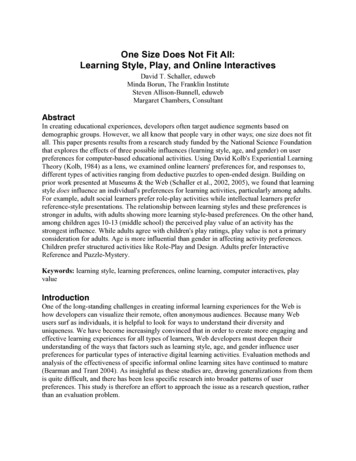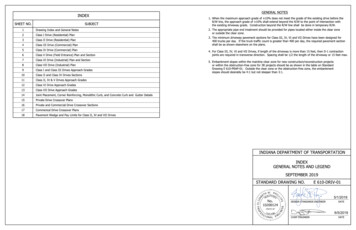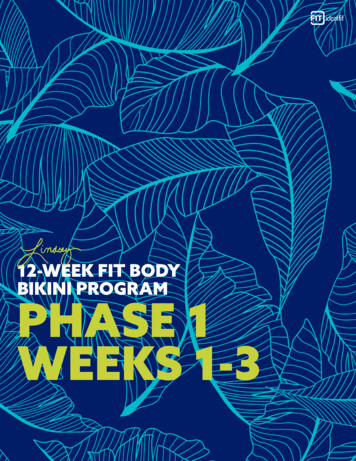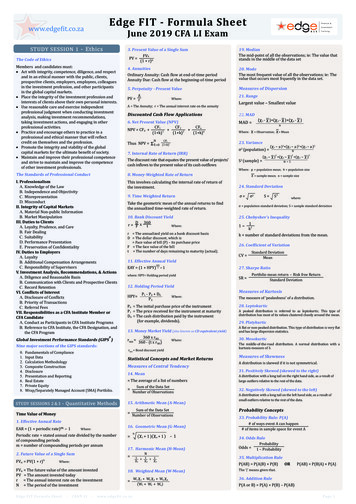
Transcription
One Size Does Not Fit All:Learning Style, Play, and Online InteractivesDavid T. Schaller, eduwebMinda Borun, The Franklin InstituteSteven Allison-Bunnell, eduwebMargaret Chambers, ConsultantAbstractIn creating educational experiences, developers often target audience segments based ondemographic groups. However, we all know that people vary in other ways; one size does not fitall. This paper presents results from a research study funded by the National Science Foundationthat explores the effects of three possible influences (learning style, age, and gender) on userpreferences for computer-based educational activities. Using David Kolb's Experiential LearningTheory (Kolb, 1984) as a lens, we examined online learners' preferences for, and responses to,different types of activities ranging from deductive puzzles to open-ended design. Building onprior work presented at Museums & the Web (Schaller et al., 2002, 2005), we found that learningstyle does influence an individual's preferences for learning activities, particularly among adults.For example, adult social learners prefer role-play activities while intellectual learners preferreference-style presentations. The relationship between learning styles and these preferences isstronger in adults, with adults showing more learning style-based preferences. On the other hand,among children ages 10-13 (middle school) the perceived play value of an activity has thestrongest influence. While adults agree with children's play ratings, play value is not a primaryconsideration for adults. Age is more influential than gender in affecting activity preferences.Children prefer structured activities like Role-Play and Design. Adults prefer InteractiveReference and Puzzle-Mystery.Keywords: learning style, learning preferences, online learning, computer interactives, playvalueIntroductionOne of the long-standing challenges in creating informal learning experiences for the Web ishow developers can visualize their remote, often anonymous audiences. Because many Webusers surf as individuals, it is helpful to look for ways to understand their diversity anduniqueness. We have become increasingly convinced that in order to create more engaging andeffective learning experiences for all types of learners, Web developers must deepen theirunderstanding of the ways that factors such as learning style, age, and gender influence userpreferences for particular types of interactive digital learning activities. Evaluation methods andanalysis of the effectiveness of specific informal online learning sites have continued to mature(Bearman and Trant 2004). As insightful as these studies are, drawing generalizations from themis quite difficult, and there has been less specific research into broader patterns of userpreferences. This study is therefore an effort to approach the issue as a research question, ratherthan an evaluation problem.
This research study is the result of collaboration between two educational Web developers(Schaller and Allison-Bunnell) and two museum researchers (Borun and Chambers). It exploresthe role of learning style, along with age and gender, in shaping the user experience of Webbased informal learning materials. We hypothesized that when the learning experience fits anindividual's dominant learning style, the experience will be more engaging and more satisfying,and thus a more successful, informal learning experience.Learning StylesThere has been little research into the role of individual preferences or learning styles in theeffectiveness of computer-based informal education. The task is confounded by the manydifferent models of learning style that have been proposed. The models do not describe the sameaspect of this complex and not easily reduced phenomenon; they focus variously on informationacquisition, processing, storage, retrieval, or application. While learning style models havebecome unfashionable in academic circles, they are commonly applied in public education andcorporate settings as a framework to recognize and accommodate individual differences.Our research employs DavidKolb's Experiential LearningTheory (ELT) (1984), whichfits well with our pre-existingtypology of educational Webactivities (Schaller et al.2002). Kolb draws on researchby Dewey and Piaget, amongothers, to identify two majordimensions of learning:perception and processing.The dimensions are visualizedas two intersecting axes (seeFigure 1). Each axis has twopoles: perception ranges fromconcrete experience toabstract conceptualization,and processing ranges fromFigure 1: Learning Styles defined by Kolb'sactive experimentation toExperiential Learning Theory.reflective observation. Thetwo axes form a four-quadrant field for mapping individual learning styles. Researchers haveapplied various labels to each of the styles represented by Kolb's quadrants. We will use ourpreferred labels in place of Kolb's labels (in parentheses) as follows: Social (Accommodating),Creative (Diverging), Intellectual (Assimilating), and Practical (Converging).The intersection of the processing and perception dimensions creates a set of learning styles,members of which are both distinct and related to adjacent styles: Social learners are leaders. They learn best by tackling a problem as a group, relying ontheir own intuition and information from other people rather than books and lectures. They2
seek out new experiences, often take risks, and employ hands-on methods to accomplish theirgoals.Creative learners are imaginative. They bring an open mind to new ideas and seek outmultiple points of view. They enjoy brainstorming with a group, though they often will listenand observe before sharing their own ideas. They rely on concrete examples to learn, andtrust their own hunches and feelings when making decisions.Intellectual learners are organized, logical, and precise. They like to learn from lectures,reading, and contemplation. They find facts, ideas, and information fascinating andpreferable to people and emotions. More scientific than artistic, they often like to conductexperiments, but can find it hard to make decisions or to take action on a matter.Practical learners are both thinkers and doers. They learn through experimentation,seeking out new ideas and finding practical applications for them. They can focus intently ona few subjects, preferring technical challenges to interpersonal matters. They are goaloriented and make decisions easily.We find this characterization of learning styles to be valuable to us because it emphasizes howpeople like to interact with content, rather than being an internal mental model of cognition.Kolb's characterization of the modalities of engagement can therefore guide developers inshaping an activity's structure to support these modalities.Research StudyThis research study, funded by the National Science Foundation, explores the relationshipbetween learning style and online interactives. Adapting an online activity typology developedfor an earlier study (Schaller et al. 2002), we hypothesized that users will prefer an activity thatmatches their dominant learning style over one that does not. Table 1 summarizes ourhypothesized correlations between activity type and learning style.Table 1: Hypothesized activity type preferences by Learning Style.Activity TypeRole-PlayAllows users to adopt a persona and interact with othercharacters.SimulationEmploys a model of the real world that users canmanipulate to develop an understanding of a complexsystem.Puzzle-MysteryInvolves analysis and deductive reasoning to reach alogical conclusion. The user relies on evidence frompeople, nature, or reference material.DesignEmphasizes open-ended inquiry and experimentation,with a personal creation as the product of the experience.Interactive ReferenceProvides multimedia content in a topical or thematicstructure, for self-directed browsing.Discussion ForumFacilitates interpersonal communication among usersand subject experts.Learning StyleSocialMight prefer this since information is gathered fromother characters in the activity.IntellectualMight find an abstract representation of the world morereadily appealing.PracticalMight be attracted to problem-solving in the real world.CreativeMight be more engaged by the opportunity to createsomething unique.IntellectualMight appeal to those with self-motivated researchgoals.SocialMight be preferred as an opportunity to interact withother people.3
We also hypothesized that if an activity type aligned well with a user's learning style, the userwould perceive that activity to be more like play than work, whereas activities that did not easilyalign with learning style would be perceived to be more like work.Our research focused on children age 10-13 (hereafter referred to as "children") but we gathereddata from all ages, allowing us to test our hypotheses with both children and adults.MethodsKolb's 12-question Learning StyleInventory (LSI) has been validatedfor high school-age youth (ages 1418) and adults (Kolb et al., 2000).Our first step was to modify the LSIfor use by our target audience ofchildren age 10-13. We changedeight words to simpler terms. Wethen deployed an online surveyconsisting of the modified LSI plusage and gender questions. Figure 2shows a sample question from theFlash-based survey, which wasdesigned to be more fun andinteractive than Kolb's paper-basedLSI in order to appeal to ourFigure 2: Survey question from Learning Styleyounger audience. We used theInventory for children.results of this survey to create anormalized distribution of learningstyles for children, such that each learning style was represented by 25% of the sample.We also piloted a two-sentencedescription of each activity type,refining each for maximalunderstanding by middle schoolstudents. We then ran a preliminaryonline survey that askedrespondents to rank order their threepreferred activity types based onour written descriptions of theactivities and to take the LSI. Figure3 shows how respondents wereasked to rank order their top threeactivity types.Figure 3: Activity Type ranking question in survey. 4
This survey was placed on several eduweb sites and linked from 11 additional museum sites. Thesurvey ran from June to October 2005 and collected a sample of 3013 respondents: 1226 middleschool-aged, 545 high school, and 1242 adults. Applying the normalized distribution to thesedata, we found significant correlations between learning style and activity preference.Individuals whose scores fell on an axis between style quadrants were eliminated.In the next phase of research, five ofeduweb's existing educationalactivities, all dealing with the topic ofanimal ecology, were selected,abridged, and modified to providebrief (3-4 minute) experiences thatexemplified five of the six activitytypes: Design, Role-Play, PuzzleMystery, Simulation, and InteractiveReference. The sixth type,Discussion, was omitted since it didnot lend itself to one-way interactionand proved least popular in thepreliminary survey. Figure 4 shows asample screen of the Design activity.Figure 4: Sample Design activity survey item.A laboratory-style face-to-face study of 154 children (age 10-13) was conducted with groupsvisiting The Franklin Institute Science Museum and at a nearby school (Friends Select School).The study consisted of the activity type rank ordering and the LSI (as in the online survey),followed by the sample activities (presented in randomized sequence) and a Likert scale ratingfor each one. Interviewers asked each child to discuss their ratings and to explain what they likedand did not like. In addition, children placed each activity on a 5-point bipolar scale (semanticdifferential) from play to work. Results of the laboratory study gave us insight into the aspects ofthe activities that appealed to individuals with each of the learning styles. The laboratory studyalso gave us interesting illustrative quotes from children.A second online survey, also linked from multiple eduweb and museum sites around the country,was conducted from May to November 2006 and produced a sample consisting of 1161 middleschool aged children, 376 high school aged children, and 1056 adults. This survey was similar tothe lab study, but since subjects did not necessarily complete all five of the sample activities,they were not asked to rank order the activities, and were scored only for the activities they didcomplete. T-tests and X2 tests determined that there were no significant differences in thepopulations by number of activities completed. The raw sample (with the exception of subjectswho scored 0 on either axis) was used to calculate frequencies of learning styles in thepopulation. All other tests for correlation used the normalized distribution. Results of this onlinesurvey are reported below.5
ResultsDistribution of Learning StylesThere is a marked variation in the distribution of learning styles among children age 10-13 and incomparison to adults. Over two-thirds of all children are Active learners with a Practical orSocial learning style. Incomparison, the majority of adultsare Abstract learners exhibitingIntellectual or Practical learningstyles. Kolb's research on teens andadults shows a similar shift towardsabstraction as people get older(Kolb 2005). It is interesting thatthe Practical learning style, at theintersection of Active and Abstract,is the most common style for bothchildren and adults.Comparing age groups, children aremore likely to have a Sociallearning style, while adults are morelikely to have an Intellectual style(Figure 5). This pattern reflects theshift toward Abstract and Reflectivemodes as people mature.Figure 5: Learning Style distributions forchildren and adults.With respect to gender and learning style, we found no difference between boys and girls.Among adults, on the other hand, more adult females had a Social learning style in comparisonto adult males.Age, Gender, and Activity PreferenceBased on
Figure 2: Survey question from Learning Style Inventory for children. Figure 3: Activity Type ranking question in survey. 5 This survey was placed on several eduweb sites and linked from 11 additional museum sites. The survey ran from June to October 2005 and collected a sample of 3013 respondents: 1226 middle-school-aged, 545 high school, and 1242 adults. Applying the normalized











